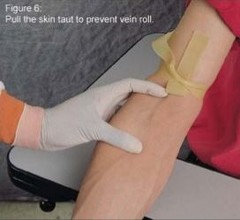Blood draw emergency?
Chi
5 years ago
last modified: 5 years ago
Featured Answer
Sort by:Oldest
Comments (45)
patriciae_gw
5 years agoRelated Discussions
Blood thinners question.
Comments (11)Aspirin doesn't work the same way and doesn't do the same thing as Warfarin. Warfarin is an old (no more drug-company patents) drug that many, many people take. It has almost no side effects other than thinning your blood. (So you needn't worry unless you will be playing football or other contact sport any tme soon!) If you are taking Warfarin and need surgery, your doctor will take you off the Warfarin and make other arrangements prior to and after the surgery. The only bother about it is that you must stick with a consistent diet and you will need to have your blood tested regularly to make sure your dosage is putting your blood within the level your doctor has prescribed. A consistent diet means that if you eat X amount of broccoli, or drink X amount of wine, you should do so regularly. For example, if you never eat broccoli, then one day eat a large portion of it, it will affect your blood "thin-ness". So, yes, there are food and other drugs that are contraindicated, but that doesn't mean you must necessarily avoid them. Only that you eat than with regularity. One important issue: most doctors are not equipped to handle long-term maintenance tests for drugs like Warfarin. There may be an "Anti-coagulation clinic" who your doctor will refer you to - the clinic will monitor your tests, bug you when you are overdue for a test, and let you know if you need to change your dose. Find out if there is such a clinic available to you and if so, definitely get your doctor to offload your Warfarin maintenance to the clinic. Good luck....See MoreTalking about blood...What is your blood type?
Comments (41)A+ ... and I used to give blood frequently, but several years ago they said that one couldn't past age 70. That didn't come into effect for me, though, for prior to that they found something in my blood that, though not a problem for me, might be troublesome for others so they wouldn't take it any more. May I add my request to that already made that you look into the possibility of giving blood, and if you can, please do so, and make a habit of it. It really is a life-saver in many situations and they are often short of needed supplies ... especially in summer, when folks go on vacation. Where else can you find an opportunity to make a life-saving gift ... at, apart from a minor prick in the arm, zero cost to you? Another mark of a good citizen. Memo particularly to folks who claim to be Christian: When your life here is complete and, on arrival at the Great Gate, you are sitting for your final exam, when you come to the question, "Did you donate blood?" and, for those who check off "No", when the question for those who choose that option is, "Why not?" ... ... what will you say? ole joyful...See MoreOGR climbers that won't draw blood?
Comments (31)'Rhode Island Red' is a good-looking rose, and I hear it's nicely fragrant. I love my 'Annie Laurie McDowell', but she's hard to come by, apparently. Her foliage reminds me of wisteria leaves, and she is fragrant and thornless and very lovely with an old-fashioned look. Another to consider is 'Zephirine Drouhin'. I don't grow her, but I'd think she'd like NOLA? She's fragrant and thornless, and would probably have some b.s. there, but you're prepared for that, so no big deal. She is pink, though not a namby-pamby pink... And how many other roses can say they've helped Hercule Poirot solve a murder mystery (in Sad Cypress)? Virginia Cross-posted with Cathy!...See MoreDoes your dental hygienist take your blood pressure before a cleaning?
Comments (90)The dentist that I had when I was young worked without an assistant most of the time. One did not have a hygienist. In both practices if he needed assistance the person at the front desk would come in and do it. But that was a simpler time and neither one of them dealt with insurance or had huge incomes or overhead. When I was in school, there was one main switchboard, and several of the departments had direct numbers. A student took over main switch board when she ate her lunch. She also passed out paychecks and pay stubs. There was one secretary receptionist in each department. There was two people in clinic management. There were three or four people who worked in the insurance office, with one interacting with the students. There is now a call center. There are three to four front desk peoplewho also answer phones as well as a coordinator in each clinic. There are layers and layers and layers of administrative staff that never existed when I was in school. There are probably 200 people doing the job of two dozen. The class size has not increased. The patient pool has not increased. Tuition of course has gone through the roof. Everything is much more complex than it used to be. When I first worked at the practice I have been at for 20 years the owner had an assistant and a front desk person and a part time hygienist. The current owner has two and a half assistants, almost two hygienists, a front desk person and there should be two, and there is a technology person who is not an employee but is probably there for several hours every month. Again, I am not sure that the patient population has increased dramatically....See Morejoyfulguy
5 years agogyr_falcon
5 years agoSEA SEA
5 years agoChi
5 years agolast modified: 5 years agopatriciae_gw
5 years agofunctionthenlook
5 years agoChi
5 years agoraee_gw zone 5b-6a Ohio
5 years agoChi
5 years agoUser
5 years agoChi
5 years agoraee_gw zone 5b-6a Ohio
5 years agoLindsey_CA
5 years ago1929Spanish-GW
5 years agoyeonassky
5 years agogyr_falcon
5 years agolast modified: 5 years agomaifleur01
5 years agoUser
5 years agolucillle
5 years agoAnnie Deighnaugh
5 years agosleeperblues
5 years agodragonflywings42
5 years agoChi
5 years agopkramer60
5 years agoAnglophilia
5 years agoUser
5 years agorob333 (zone 7b)
5 years agoamylou321
5 years agolast modified: 5 years agomaifleur01
5 years agoChi
5 years agolast modified: 5 years agopetalique
5 years agoMDLN
5 years agoLindsey_CA
5 years agoMDLN
5 years agoquasifish
5 years agomaifleur01
5 years agoclt3
5 years agopatriciae_gw
5 years agoElmer J Fudd
5 years agoDawnInCal
5 years agolast modified: 5 years agoChi
5 years agoLindsey_CA
5 years agoElmer J Fudd
5 years ago
Related Stories

WORLD OF DESIGNModern Mosaic: Anne Dérian’s Art Emerges Piece by Piece
See how a French architect in Berlin creates stunning ceramic installations for the home
Full Story
RED FOLIAGEGreat Design Plant: Japanese Blood Grass
This dramatic, ruby-tinged grass bridges the gap between red and green, short and tall plants
Full Story
DISASTER PREP & RECOVERYHouzz Tour: Modern Farmhouse Emerges From Hurricane Sandy Devastation
A homeowner loses her cottage but gains a new energy-efficient, low-maintenance home
Full Story
GARDENING AND LANDSCAPING9 Flowers That Draw Butterflies
Charm winged beauties and human visitors alike with these enticing, fragrant and colorful blooms for the garden
Full Story
REMODELING GUIDESPlan Your Home Remodel: The Design and Drawing Phase
Renovation Diary, Part 2: A couple has found the right house, a ranch in Florida. Now it's time for the design and drawings
Full Story
KITCHEN MAKEOVERSCharming Kitchen Emerges From a Dilapidated Portland Home
An Oregon designer and her husband remodel a tiny green kitchen into the kitchen of their dreams
Full Story
KITCHEN DESIGNNew Looks for Cabinets and Countertops Emerging in 2019
Dark colors, wood patterns and thin surfaces are a few of the trends seen at the recent Kitchen & Bath Industry Show
Full Story
EVENTSEmerging Interior Design Trends From Maison & Objet 2019
See new furniture, materials, patterns and colors showcased at the September trade fair in Paris
Full Story
BEDROOMSThis Teen Girl's Room Has Total Grown-up Appeal
With a textured blue wall, a mod white bed and even a Lichtenstein, this teen's bedroom draws envy beyond her age group
Full Story
DECORATING GUIDES7 Tips to Sell Your Home Faster to a Younger Buyer
Draw today's home buyers by appealing to their tastes, with these guidelines from an expert decorator
Full Story







raee_gw zone 5b-6a Ohio